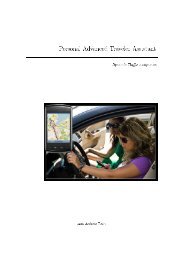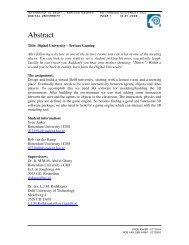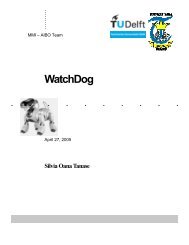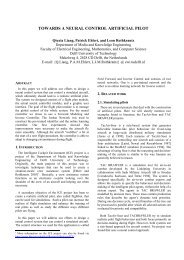Recognition of facial expressions - Knowledge Based Systems ...
Recognition of facial expressions - Knowledge Based Systems ...
Recognition of facial expressions - Knowledge Based Systems ...
Create successful ePaper yourself
Turn your PDF publications into a flip-book with our unique Google optimized e-Paper software.
<strong>of</strong> prototypic emotions (i.e., joy, surprise, anger, fear, disgust, and sadness). For the<br />
available portion <strong>of</strong> the database, these six tasks and mouth opening in the absence <strong>of</strong><br />
other action units were coded by a certified FACS coder. Seventeen percent <strong>of</strong> the data<br />
were comparison coded by a second certified FACS coder. Inter-observer agreement was<br />
quantified with coefficient kappa, which is the proportion <strong>of</strong> agreement above what<br />
would be expected to occur by chance (Cohen, 1960; Fleiss, 1981). The mean kappa for<br />
inter-observer agreement was 0.86.<br />
Image sequences from neutral to target display were digitized into 640 by 480 or 490<br />
pixel arrays with 8-bit precision for grayscale values. The image format is “png”. Images<br />
were labeled using their corresponding VITC.<br />
FACS codes for the final frame in each image sequence were available for the analysis.<br />
In some cases the codes have been revised. The final frame <strong>of</strong> each image sequence was<br />
coded using FACS action units (AU), which are reliable descriptions <strong>of</strong> the subject's<br />
expression.<br />
In order to make the task <strong>of</strong> computing the model parameter values possible, a s<strong>of</strong>tware<br />
application was developed. It <strong>of</strong>fered the possibility to manually plot certain points on<br />
each image <strong>of</strong> the database in an easy manner. The other components <strong>of</strong> the system<br />
automatically computed the values <strong>of</strong> the parameters so as to be ready for the training<br />
step for the neuronal networks or for computing the probabilities table in the case <strong>of</strong><br />
BBN.<br />
SMILE BBN library<br />
SMILE [Structural Modeling, Inference, and Learning Engine] is a fully platform<br />
independent library <strong>of</strong> C++ classes implementing graphical probabilistic and decision<br />
theoretic models, such as Bayesian networks, influence diagrams, and structural equation<br />
models. It was designed in a platform independent fashion as an object oriented robust<br />
platform. It has releases starting from 1997. The interface is so defined as to provide the<br />
developers with different tools for creating, editing, saving and loading <strong>of</strong> graphical<br />
models. The most important feature is related to the ability to use the already defined<br />
models for probabilistic reasoning and decision making under uncertainty. The release <strong>of</strong><br />
- 60 -
















